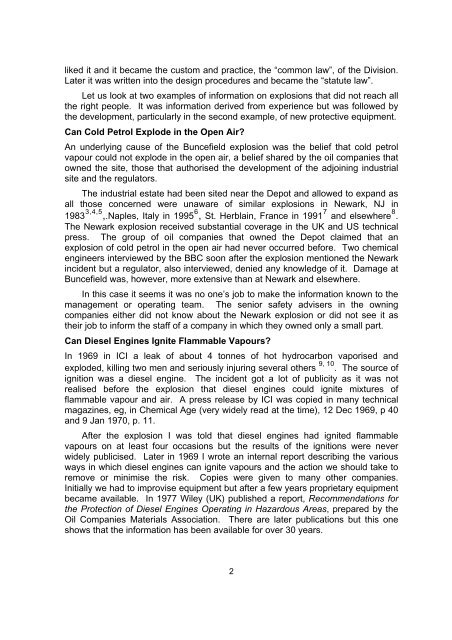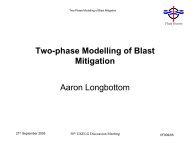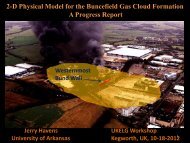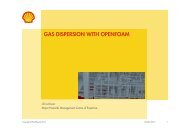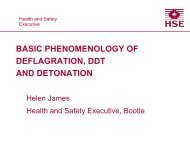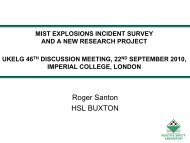Create successful ePaper yourself
Turn your PDF publications into a flip-book with our unique Google optimized e-Paper software.
liked it and it became the custom and practice, the “common law”, of the Division.<br />
Later it was written into the design procedures and became the “statute law”.<br />
Let us look at two examples of information on explosions that did not reach all<br />
the right people. It was information derived from experience but was followed by<br />
the development, particularly in the second example, of new protective equipment.<br />
Can Cold Petrol Explode in the Open Air?<br />
An underlying cause of the Buncefield explosion was the belief that cold petrol<br />
vapour could not explode in the open air, a belief shared by the oil companies that<br />
owned the site, those that authorised the development of the adjoining industrial<br />
site and the regulators.<br />
The industrial estate had been sited near the Depot and allowed to expand as<br />
all those concerned were unaware of similar explosions in Newark, NJ in<br />
3, ,<br />
1983 4 5 ,.Naples, Italy in 1995 6 , St. Herblain, France in 1991 7 and elsewhere 8 .<br />
The Newark explosion received substantial coverage in the UK and US technical<br />
press. The group of oil companies that owned the Depot claimed that an<br />
explosion of cold petrol in the open air had never occurred before. Two chemical<br />
engineers interviewed by the BBC soon after the explosion mentioned the Newark<br />
incident but a regulator, also interviewed, denied any knowledge of it. Damage at<br />
Buncefield was, however, more extensive than at Newark and elsewhere.<br />
In this case it seems it was no one’s job to make the information known to the<br />
management or operating team. The senior safety advisers in the owning<br />
companies either did not know about the Newark explosion or did not see it as<br />
their job to inform the staff of a company in which they owned only a small part.<br />
Can Diesel Engines Ignite Flammable Vapours?<br />
In 1969 in ICI a leak of about 4 tonnes of hot hydrocarbon vaporised and<br />
exploded, killing two men and seriously injuring several others 9, 10 . The source of<br />
ignition was a diesel engine. The incident got a lot of publicity as it was not<br />
realised before the explosion that diesel engines could ignite mixtures of<br />
flammable vapour and air. A press release by ICI was copied in many technical<br />
magazines, eg, in Chemical Age (very widely read at the time), 12 Dec 1969, p 40<br />
and 9 Jan 1970, p. 11.<br />
After the explosion I was told that diesel engines had ignited flammable<br />
vapours on at least four occasions but the results of the ignitions were never<br />
widely publicised. Later in 1969 I wrote an internal report describing the various<br />
ways in which diesel engines can ignite vapours and the action we should take to<br />
remove or minimise the risk. Copies were given to many other companies.<br />
Initially we had to improvise equipment but after a few years proprietary equipment<br />
became available. In 1977 Wiley (UK) published a report, Recommendations for<br />
the Protection of Diesel Engines Operating in Hazardous Areas, prepared by the<br />
Oil Companies Materials Association. There are later publications but this one<br />
shows that the information has been available for over 30 years.<br />
2


